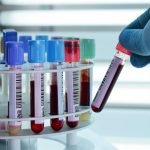PSA and Beyond: Using Blood Testing to Assess for Prostate Cancer
Dicken Weatherby, ND
Prostate cancer is currently the second leading cause of cancer-related deaths in U.S. men. Prostatic cells are more prone to mutation than other cells of the male reproductive system, and evidence from autopsies showed that 34% of men aged 40-49 had histological evidence of latent prostate cancer. This rose to 70% in men aged 80 or older (Holund, 1980). With so many men experiencing health issues related to the prostate, it’s essential for doctors to be screening for this. And, as a functionally oriented physician, I appreciate the many tests available that can help steer a course to prevent, slow the progression of and reverse prostate disease.
There is too much information to cover everything on blood testing for prostate cancer in one article, so I’ll give a brief overview and mention several tests I like to run. Prostate-specific antigen (PSA) is the one that comes to mind first, but many other tests complement the PSA result to create a more comprehensive diagnostic picture.
PSA: Background
PSA, the most abundant protein synthesized in the prostate gland, is a serine protease enzyme that helps liquefy the male ejaculate to facilitate fertilization. The majority of PSA stays within the prostatic ducts, which is why blood levels of PSA, in a healthy prostate, are typically less than 1.0ng/ml. Unfortunately, the enzymatic activity of PSA can break up the extracellular matrix surrounding the cells and can actually hasten the spread of cancer as well as increase blood levels of PSA.
Increased levels of PSA can indicate prostate cancer or less serious conditions, such as benign prostatic hyperplasia and prostatitis.
Prostate Cancer and Risk Factors
Age seems to be the most common risk factor, with a high percentage of prostate cancer cases occurring in men age 65 and older. As a preventive-oriented practitioner, I believe prostate issues begin long before most are detected, so I recommend that men older than 35 begin testing for PSA levels annually to help establish PSA velocity and PSA doubling time.
Other reported risk factors for prostate cancer are race, lifestyle/environmental factors and family history. Men who have a father or brother with prostate cancer have a greater chance of developing prostate cancer. African American men have the highest rate of prostate cancer, while Asian and Native American men have the lowest rates.
There is new evidence that in obese men, PSA levels can be deceptively low in cases of prostate disease or cancer. So PSA alone should not be used to rule out cancer, especially in obese men.
PSA Ranges
In the past, most doctors considered PSA values below 4.0ng/ml as normal. However, most functionally oriented doctors have much tighter ranges. The Journal of Urology reported in 2004 that 22% of patients with PSA levels between 2.6 and 4.0ng/ml had prostate cancer, and on biopsy the cancer was deemed “significant.” The leading researchers concluded that “an important number of cancers could be detected in the PSA range of 2.6 to 4.0ng/ml” (Nadler et al., 2005). Given this research, I like to see PSA tests below 2.6ng/ml.
Expanding PSA Readings
It is unwise in medicine to rely on one method of evaluation, and I recommend considering a number of other assessment modalities to increase accuracy in the assessment of prostate health. PSA levels alone tell us something, but far more information is available if we look beyond the static measurement to the interrelationships between levels over time. I recommend using the following in a comprehensive risk assessment for patients.
- PSA Velocity (PSAV): PSAV is based on changes in PSA over time. It seems that the rate of increase in PSA is actually more important as a predictor of mortality than the PSA reading itself. A sharp rise in the PSA level raises the suspicion of cancer. In a study published in the New England Journal of Medicine, men who showed a 2.0ng/ml or greater increase in PSA from the previous year’s reading were 10 times more likely to die within seven years (D’Amico et al., 2004).
- PSA Doubling Time (PSADT): PSADT looks at the amount of time it takes for the PSA level to double, and is a reflection of tumor growth. For instance, the average PSADT for prostate cancer is 48 months. Men with optimal prostate health have no appreciable rise in PSA. It is a cause for concern if the PSA level doubles in less than 12 years.
- PSA Density (PSAD): PSAD considers the relationship of the PSA level to the size of the prostate and is helpful in diagnosing prostate cancer. The size of the prostate can be determined by radiological or ultrasound evaluation. PSAD is calculated by dividing the PSA result (in nanograms/ml) by an accurate determination of prostate gland volume. PSAD results above 0.15ng/cc are associated with a diagnosis of prostate cancer.
Other Primary Biomarkers to Consider
Tumor cells produce specific products that play a role in the growth, spread and metastasis of the tumor. We can measure many of these products, which are known as biomarkers, in the blood. An increase in tumor activity and size is often accompanied by an increase in these biomarkers. Following are some biomarkers to be aware of for prostate cancer:
- Prostatic Acid Phosphatase (PAP). I firmly believe that we should be running baseline PSA tests and following the results over many years. I also think we should run a baseline PAP and regularly check this test, as well. PAP levels will begin to rise when prostate cancer has begun to spread beyond the capsule to other parts of the body. Unlike PSA, it is less likely to be elevated from other causes and is helpful for monitoring the effectiveness of treatment and as an independent predictor of recurrence. Levels above 3.0ng/ml are associated with a higher probability of disease outside the prostate.
- Prolactin. Prolactin is a hormone produced in the pituitary gland of both men and women. Pioneering work by Dr. Nevalainen and colleagues at Georgetown University Medical Center showed that prolactin serves as a local growth factor for prostate cells (Nevalainen, 2003). The normal range for prolactin levels in men is 2.17 to 17.7ng/ml.
Other tests to consider:
- D-Dimer. Because prostate cancer can cause higher risk of thrombosis, it’s a good idea to keep track of D-dimer levels, a sensitive marker of coagulation. D-dimer can indicate if the patient has an existing clot or risk of a clot. Most doctors would read levels between 0-1 as acceptable, being fairly certain no clot is indicated. But as a functionally oriented physician, I like to see D-Dimer levels below 0.40, which to me is the optimal range.
- Fibrinogen. This is a very important test in predicting cancer development or progression. Fibrinogen is the precursor of fibrin. Research suggests that cancer cells use fibrin to coat themselves in order to slow down their recognition by the immune system.
Like D-dimer, fibrinogen can also be a good predictor of blood clots. Patients with cancer often show a hyper-coagulation state, with elevated fibrinogen playing a major role. Anti-coagulant drugs such as heparin, which break down fibrin in the body, have been shown to improve survival rates. Levels are best kept below 350mg/dl.
- Interleukin-6 (IL-6) and C-Reactive Protein (CRP). It is known that inflammation is involved in prostate cancer development and progression. IL-6 and CRP are two of the inflammatory markers that have been most strongly connected with prostate cancer. High CRP levels in men are associated with a 40% higher risk of prostate cancer, and a high pre-diagnostic IL-6 reading may lead to a less-than-optimal prostate cancer outcome (Stark, 2006). High levels of IL-6 and CRP may be responsible, at least in some part, for creating an environment in which cancer is more likely to develop and progress.
I like to see numbers of CRP below 0.55mg/L for men and 0.8mg/L for women, and levels of IL-6 below 150pg/ml.
- Insulin and Metabolic Syndrome. There seems to be a link between insulin resistance and prostate cancer. So, it’s a good idea to keep an eye on fasting insulin, glucose, hemoglobin A1C, IGF-1, C-peptide, lipid panels and leptin levels.
More and more research is coming out on preventing, tracking and treating prostate cancer. I have only introduced the topic of blood testing for prostate disease, with the aim of illustrating the possibilities that exist. I urge all alternative practitioners to use what’s available to help patients, and to keep up with the exciting advancements in this field.
 Dicken Weatherby, ND is based in southern Oregon. A graduate of NCNM, Dicken is co-author of the bestselling book Blood Chemistry and CBC Analysis-Clinical Laboratory Testing from a Functional Perspective. He has self-published seven other books in the field of alternative medical diagnosis, has created numerous information products, and runs a number of successful Web sites (www.BloodChemistryAnalysis.com, www.Health-E-Marketing.com and www.StrawBale.com). He is involved in research, writing and consulting, and teaches functional diagnosis seminars in both the U.S. and his native country, the U.K.
Dicken Weatherby, ND is based in southern Oregon. A graduate of NCNM, Dicken is co-author of the bestselling book Blood Chemistry and CBC Analysis-Clinical Laboratory Testing from a Functional Perspective. He has self-published seven other books in the field of alternative medical diagnosis, has created numerous information products, and runs a number of successful Web sites (www.BloodChemistryAnalysis.com, www.Health-E-Marketing.com and www.StrawBale.com). He is involved in research, writing and consulting, and teaches functional diagnosis seminars in both the U.S. and his native country, the U.K.
References
Holund B: Latent prostatic cancer in a consecutive autopsy series, Scand J Urol Nephrol 14(1):29-35, 1980.
Nadler RB et al: Use of 2.6ng/ml prostate specific antigen prompt for biopsy in men older than 60 years, J Urol. Dec;174(6):2154-7, 2005.
D’Amico AV et al: Preoperative PSA velocity and the risk of death from prostate cancer after radical prostatectomy, N Engl J Med Jul 8;351(2):125-35, 2004.
Nevalainen M: Researchers discover effective method for killing prostate cancer cells, AScribe News Inc. May Georgetown University Medical Center, 2003.
Stark JR: IL-6, CRP Levels Tied to Prostate Cancer Development, Lethality, American Association for Cancer Research’s Frontiers in Cancer Prevention Research Meeting in Boston, Nov 2006., Reuters Health Information.










